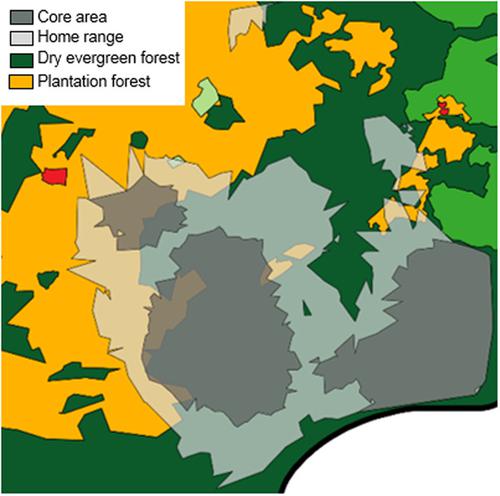当前位置:
X-MOL 学术
›
Am. J. Primatol.
›
论文详情
Our official English website, www.x-mol.net, welcomes your
feedback! (Note: you will need to create a separate account there.)
Northern pigtailed macaques rely on old growth plantations to offset low fruit availability in a degraded forest fragment.
American Journal of Primatology ( IF 2.0 ) Pub Date : 2020-02-28 , DOI: 10.1002/ajp.23117 Eva Gazagne 1, 2 , Juan Manuel José-Domínguez 2, 3 , Marie-Claude Huynen 1 , Alain Hambuckers 1 , Pascal Poncin 4 , Tommaso Savini 2 , Fany Brotcorne 1
American Journal of Primatology ( IF 2.0 ) Pub Date : 2020-02-28 , DOI: 10.1002/ajp.23117 Eva Gazagne 1, 2 , Juan Manuel José-Domínguez 2, 3 , Marie-Claude Huynen 1 , Alain Hambuckers 1 , Pascal Poncin 4 , Tommaso Savini 2 , Fany Brotcorne 1
Affiliation

|
Space-use and foraging strategies are important facets to consider in regard to the ecology and conservation of primates. For this study, we documented movement, ranging, and foraging patterns of northern pigtailed macaques (Macaca leonina) for 14 months in a degraded habitat with old growth Acacia and Eucalyptus plantations at the Sakaerat Biosphere Reserve in northeastern Thailand. We used hidden Markov models and characteristic hull polygons to analyze these patterns in regard to fruit availability. Macaques' home range (HR) was 599 ha and spanned through a natural dry-evergreen forest (DEF), and plantation forest. Our results showed that active foraging increased with higher fruit availability in DEF. Macaques changed to a less continuous behavioral state during periods of lower fruit availability in DEF, repeatedly moving from foraging to transiting behavior, while extending their HR further into plantation forest and surrounding edge areas. Concomitantly, macaques shifted their diet from fleshy to dry fruit such as the introduced Acacia species. Our results showed that the diet and movement ecology adaptations of northern pigtailed macaques were largely dependent on availability of native fruits, and reflected a "high-cost, high-yield" foraging strategy when fresh food was scarce and dry fruit was available in plantation forest. Conversely, wild-feeding northern pigtailed macaque populations inhabiting pristine habitat approached a "low-cost, low-yield" foraging strategy. Our results outline the effects of habitat degradation on foraging strategies and show how a flexible species can cope with its nutritional requirements.
中文翻译:

北部尾纤的猕猴依靠古老的人工林来弥补退化的森林碎片中水果供应不足的问题。
在灵长类动物的生态和保护方面,空间利用和觅食策略是要考虑的重要方面。在本研究中,我们记录了泰国东北Sakaerat生物圈保护区中退化的栖息地中退化的栖息地中的北尾猕猴(Macaca leonina)的活动,范围和觅食方式,历时14个月。我们使用隐马尔可夫模型和特征性船体多边形来分析这些与水果供应量有关的模式。猕猴的家园(HR)面积为599公顷,横跨天然的干燥常绿森林(DEF)和人工林。我们的结果表明,积极的觅食随着DEF中较高的水果利用率而增加。猕猴在DEF中的水果供应量较低时,其行为状态变得不连续。不断地从觅食转变为过渡行为,同时将其人力资源进一步扩展到人工林和周边地区。随之而来的是,猕猴的饮食从肉质转变为干果,例如引入的相思树种。我们的研究结果表明,北部尾纤猕猴的饮食和运动生态适应性很大程度上取决于本地水果的可利用性,并反映了人工林中缺乏新鲜食物和干果时的“高成本,高产”觅食策略。 。相反,居住在原始生境中的北部野马尾猕猴的野生饲料则采取了“低成本,低产”的觅食策略。我们的研究结果概述了栖息地退化对觅食策略的影响,并显示了灵活的物种如何应对其营养需求。
更新日期:2020-02-28
中文翻译:

北部尾纤的猕猴依靠古老的人工林来弥补退化的森林碎片中水果供应不足的问题。
在灵长类动物的生态和保护方面,空间利用和觅食策略是要考虑的重要方面。在本研究中,我们记录了泰国东北Sakaerat生物圈保护区中退化的栖息地中退化的栖息地中的北尾猕猴(Macaca leonina)的活动,范围和觅食方式,历时14个月。我们使用隐马尔可夫模型和特征性船体多边形来分析这些与水果供应量有关的模式。猕猴的家园(HR)面积为599公顷,横跨天然的干燥常绿森林(DEF)和人工林。我们的结果表明,积极的觅食随着DEF中较高的水果利用率而增加。猕猴在DEF中的水果供应量较低时,其行为状态变得不连续。不断地从觅食转变为过渡行为,同时将其人力资源进一步扩展到人工林和周边地区。随之而来的是,猕猴的饮食从肉质转变为干果,例如引入的相思树种。我们的研究结果表明,北部尾纤猕猴的饮食和运动生态适应性很大程度上取决于本地水果的可利用性,并反映了人工林中缺乏新鲜食物和干果时的“高成本,高产”觅食策略。 。相反,居住在原始生境中的北部野马尾猕猴的野生饲料则采取了“低成本,低产”的觅食策略。我们的研究结果概述了栖息地退化对觅食策略的影响,并显示了灵活的物种如何应对其营养需求。











































 京公网安备 11010802027423号
京公网安备 11010802027423号